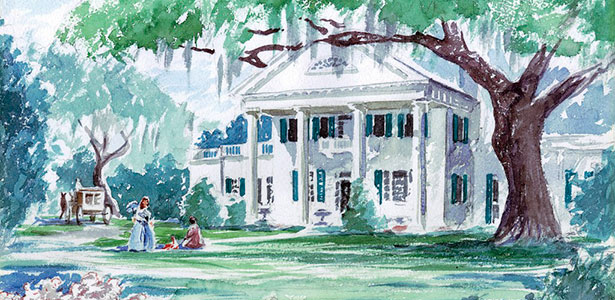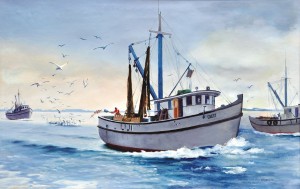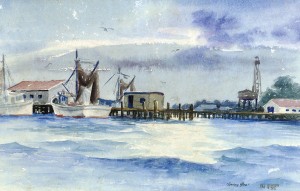The Way We Were

I am always nervous right before a phone interview. Talking to someone new without seeing them face-to-face can leave me anxious at times. I dialed the number Thomas “Tommy” Harrelson had given me when I asked to interview him about “Southport’s Art Newton”—his biography of Southport’s first professional artist. He picked up on the second ring, and on the other end of the line I heard a smooth, comforting voice: “Hey Sara Beth, how are you doing?” I was immediately put at ease. It was as if I was talking to a friend.

‘Southport’s Art Newton’ is a biography and collection of art about our area’s first professional artist, Art Newton. The book, released in the fall of 2013, was penned by local Thomas J. Harrelson, who once studied under Newton. Image courtesy of David Norris with SlapDash Publishing.
I have to admit that before I was assigned this article, I had never heard of Harrelson or “Southport’s Art Newton” before. Being new to the Southport area, I have been taking in any and all information about this town that I can. I would like to think I am the lucky one getting the opportunity to interview Harrelson and learning this history firsthand.
Art Newton was a photographer, artist, husband, father and friend. After finishing school in Southport, he served in the U.S. Coast Guard during World War II. He then went to finish his studies at the Central Academy of Commercial Art in Cincinnati and the Ozenfant School of Fine Art in New York. After returning home, he taught art classes at Southport High School as well as private lessons.
Newton always had his hand in a little bit of everything in Southport. He ran a camera shop in downtown, designed billboards, turned his photos into postcards and sold them around town, and sketched every boat he could get his eye on.
“He was too easily forgotten,” Harrelson told me when I asked what inspired him to put together this impressionistic collection. When Newton was alive, people bought his art and hung it in their homes and the paintings just became a part of the house—like the windows and walls. Harrelson emphasized to me that people truly did not know what they had in Newton’s art. This tendency stayed true for some time after Newton’s passing. Harrelson had a strong desire for the citizens of Southport to really appreciate and understand what treasures they had. He wanted the spirit of Newton to live on throughout the town and in their hearts.
Harrelson started out with a small collection of Newton’s paintings that he later grew by purchasing more art from town residents. But he wanted to tell the story of Newton, and he wanted Southport to know the story that Newton told about them. Newton’s life unfolded into a passion for Harrelson that he knew he could not keep to himself.
Harrelson, a Southport native, took art lessons from Newton as a young boy. “I remember the things he would talk about in art class,” Harrelson reminisced. He told of how his father bought a painting from Newton in 1950 for $15. Harrelson’s father gave him that painting when he grew up and he spoke of it fondly.
“Others in the area would sell me their art; I was even able to buy some of Newton’s pencil collections from his wife, which are some of my most prized possessions.”
Harrelson spoke of Newton’s work fervently, and even over the phone I could sense how honored he felt being able to enrich my mind with the tales of his former mentor. “Newton knew how to paint—he was able to capture the way we were in his watercolors, a true talent that was all his own. He was Southport. He knew this town better than the town knew itself—what a rarity that is.”
Over the years after Harrelson accrued an extensive collection of Newton’s work, a friend came to him suggesting that he compile the art into a book. He had to get permission from Newton’s children first before he could follow through. “The family kept all kinds of records of art exhibits and of who bought the paintings. That is how I was able to track down the people in Southport who owned his work,” the author reveals.
Harrelson was fortunate enough that they let him borrow the paintings to put copies into his book. He brought all of Newton’s pieces together that he was able to get his hands on, and with the help of SlapDash Publishing, “Southport’s Art Newton” was given life.
Some of Harrelson’s favorite pieces of Newton’s are his watercolors. “He was one of the best water colorists of his time,” Harrelson tells.
Flipping through the pages of the book, one can truly see that Newton captured so much emotion in his paintings. “Newton knew about the work that went into Southport day in and day out. He knew how those shrimp boats worked just as well as he knew how to paint them.”
There is an entire chapter in the book dedicated to these shrimp boats. Harrelson writes, “For some reason, Art particularly liked to paint shrimp boats. Maybe it was a reflection of the sheer numbers of vessels in the area. In fact, his 1952 exhibition at the American Legion Room at City Hall (now the upstairs of the Franklin Art Gallery) was entitled “Shrimpers at Work and Rest.”
Newton was able to capture a county that is now long gone; he preserved the memories of a time when Southport belonged to the fishermen and when there was more sand than pavement. He captured beaches, churches, parts of Wilmington and Bald Head Island, and even tragedies such as the aftermath of when Hurricane Hazel took over Brunswick County. He left nothing to chance and hoped that his pictures would live on long after he was gone. On July 16th, 1964, Newton passed away tragically in the place he felt most at home—the Cape Fear River. He was laid to rest in the Old Smithville Burying Ground in Southport.
Not many of Newton’s paintings are on display, Harrelson told me. There are a few places in town such as the library and the NC Maritime Museum where Newton’s artwork hangs. But Southport residents are in for a real treat in July. Harrelson revealed there will be an exhibit of Newton’s works displayed the entire month at the Fort Johnston-Southport Museum and Visitor’s Center (203 E. Bay Street). This event will host Newton’s original work, and some of his family and friends will be in attendance. The Fort Johnston-Southport Museum and Visitor’s Center is open Monday through Saturday from 9:30 a.m. until 4:30 p.m. and on Sunday from 1 p.m. until 4 p.m.
To purchase “Southport’s Art Newton” visit I am always nervous right before a phone interview. Talking to someone new without seeing them face-to-face can leave me anxious at times. I dialed the number Thomas “Tommy” Harrelson had given me when I asked to interview him about “Southport’s Art Newton”—his biography of Southport’s first professional artist. He picked up on the second ring, and on the other end of the line I heard a smooth, comforting voice: “Hey Sara Beth, how are you doing?” I was immediately put at ease. It was as if I was talking to a friend.
I have to admit that before I was assigned this article, I had never heard of Harrelson or “Southport’s Art Newton” before. Being new to the Southport area, I have been taking in any and all information about this town that I can. I would like to think I am the lucky one getting the opportunity to interview Harrelson and learning this history firsthand.
Art Newton was a photographer, artist, husband, father and friend. After finishing school in Southport, he served in the U.S. Coast Guard during World War II. He then went to finish his studies at the Central Academy of Commercial Art in Cincinnati and the Ozenfant School of Fine Art in New York. After returning home, he taught art classes at Southport High School as well as private lessons.
Newton always had his hand in a little bit of everything in Southport. He ran a camera shop in downtown, designed billboards, turned his photos into postcards and sold them around town, and sketched every boat he could get his eye on.
“He was too easily forgotten,” Harrelson told me when I asked what inspired him to put together this impressionistic collection. When Newton was alive, people bought his art and hung it in their homes and the paintings just became a part of the house—like the windows and walls. Harrelson emphasized to me that people truly did not know what they had in Newton’s art. This tendency stayed true for some time after Newton’s passing. Harrelson had a strong desire for the citizens of Southport to really appreciate and understand what treasures they had. He wanted the spirit of Newton to live on throughout the town and in their hearts.
Harrelson started out with a small collection of Newton’s paintings that he later grew by purchasing more art from town residents. But he wanted to tell the story of Newton, and he wanted Southport to know the story that Newton told about them. Newton’s life unfolded into a passion for Harrelson that he knew he could not keep to himself.
Harrelson, a Southport native, took art lessons from Newton as a young boy. “I remember the things he would talk about in art class,” Harrelson reminisced. He told of how his father bought a painting from Newton in 1950 for $15. Harrelson’s father gave him that painting when he grew up and he spoke of it fondly.
“Others in the area would sell me their art; I was even able to buy some of Newton’s pencil collections from his wife, which are some of my most prized possessions.”
Harrelson spoke of Newton’s work fervently, and even over the phone I could sense how honored he felt being able to enrich my mind with the tales of his former mentor. “Newton knew how to paint—he was able to capture the way we were in his watercolors, a true talent that was all his own. He was Southport. He knew this town better than the town knew itself—what a rarity that is.”
Over the years after Harrelson accrued an extensive collection of Newton’s work, a friend came to him suggesting that he compile the art into a book. He had to get permission from Newton’s children first before he could follow through. “The family kept all kinds of records of art exhibits and of who bought the paintings. That is how I was able to track down the people in Southport who owned his work,” the author reveals.
Harrelson was fortunate enough that they let him borrow the paintings to put copies into his book. He brought all of Newton’s pieces together that he was able to get his hands on, and with the help of SlapDash Publishing, “Southport’s Art Newton” was given life.
Some of Harrelson’s favorite pieces of Newton’s are his watercolors. “He was one of the best water colorists of his time,” Harrelson tells.
Flipping through the pages of the book, one can truly see that Newton captured so much emotion in his paintings. “Newton knew about the work that went into Southport day in and day out. He knew how those shrimp boats worked just as well as he knew how to paint them.”
There is an entire chapter in the book dedicated to these shrimp boats. Harrelson writes, “For some reason, Art particularly liked to paint shrimp boats. Maybe it was a reflection of the sheer numbers of vessels in the area. In fact, his 1952 exhibition at the American Legion Room at City Hall (now the upstairs of the Franklin Art Gallery) was entitled “Shrimpers at Work and Rest.”
Newton was able to capture a county that is now long gone; he preserved the memories of a time when Southport belonged to the fishermen and when there was more sand than pavement. He captured beaches, churches, parts of Wilmington and Bald Head Island, and even tragedies such as the aftermath of when Hurricane Hazel took over Brunswick County. He left nothing to chance and hoped that his pictures would live on long after he was gone. On July 16th, 1964, Newton passed away tragically in the place he felt most at home—the Cape Fear River. He was laid to rest in the Old Smithville Burying Ground in Southport.
Not many of Newton’s paintings are on display, Harrelson told me. There are a few places in town such as the library and the NC Maritime Museum where Newton’s artwork hangs. But Southport residents are in for a real treat in July. Harrelson revealed there will be an exhibit of Newton’s works displayed the entire month at the Fort Johnston-Southport Museum and Visitor’s Center (203 E. Bay Street). This event will host Newton’s original work, and some of his family and friends will be in attendance. The Fort Johnston-Southport Museum and Visitor’s Center is open Monday through Saturday from 9:30 a.m. until 4:30 p.m. and on Sunday from 1 p.m. until 4 p.m.
To purchase “Southport’s Art Newton” visit http://www.carolinabeach.net/harrelson1.html. The book also is available locally at Art at 211/Ricky Evans Gallery, 211 N. Howe Street.














Leave a Reply